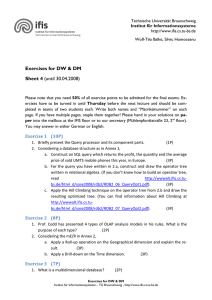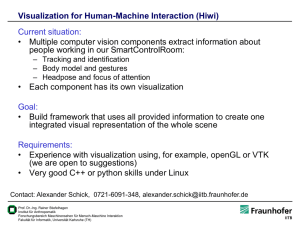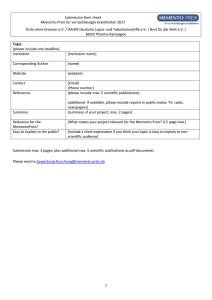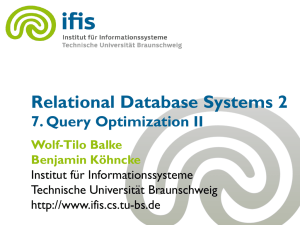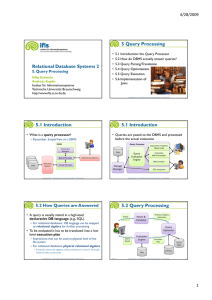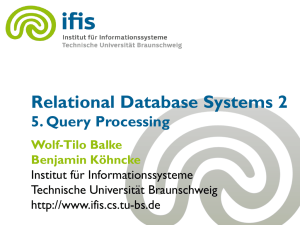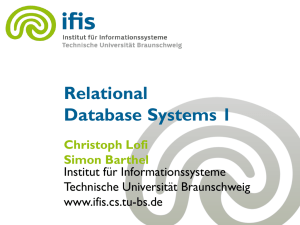Excercises for Relational Databases 2 - IfIS
Werbung
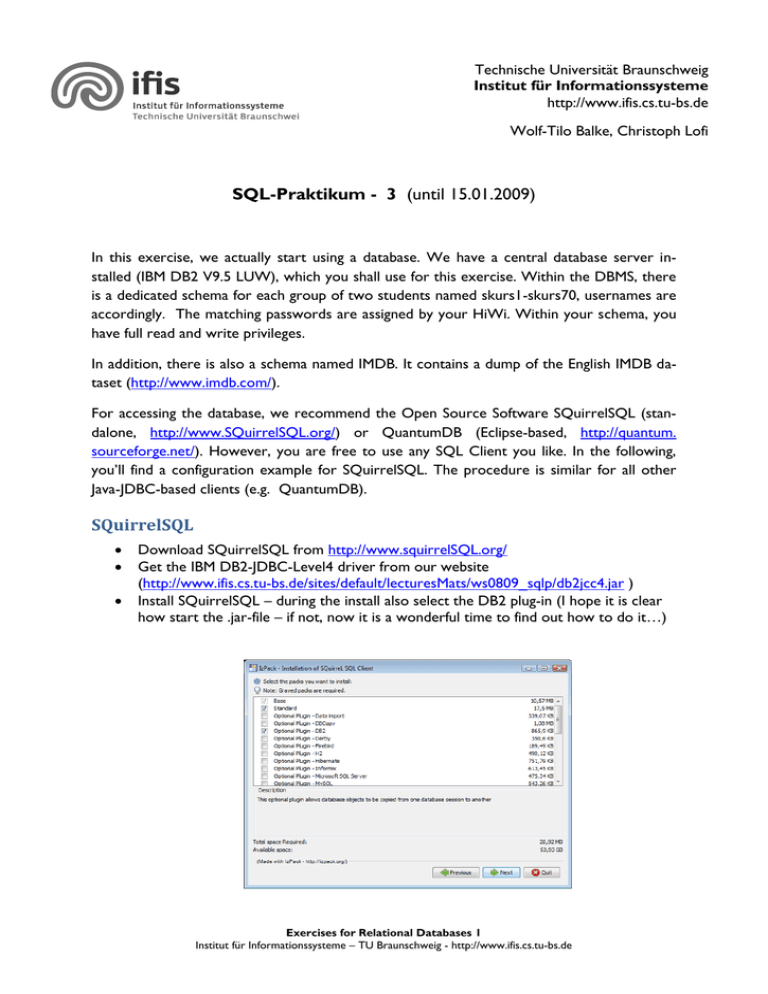
Technische Universität Braunschweig Institut für Informationssysteme http://www.ifis.cs.tu-bs.de Wolf-Tilo Balke, Christoph Lofi SQL-Praktikum - 3 (until 15.01.2009) In this exercise, we actually start using a database. We have a central database server installed (IBM DB2 V9.5 LUW), which you shall use for this exercise. Within the DBMS, there is a dedicated schema for each group of two students named skurs1-skurs70, usernames are accordingly. The matching passwords are assigned by your HiWi. Within your schema, you have full read and write privileges. In addition, there is also a schema named IMDB. It contains a dump of the English IMDB dataset (http://www.imdb.com/). For accessing the database, we recommend the Open Source Software SQuirrelSQL (standalone, http://www.SQuirrelSQL.org/) or QuantumDB (Eclipse-based, http://quantum. sourceforge.net/). However, you are free to use any SQL Client you like. In the following, you’ll find a configuration example for SQuirrelSQL. The procedure is similar for all other Java-JDBC-based clients (e.g. QuantumDB). SQuirrelSQL Download SQuirrelSQL from http://www.squirrelSQL.org/ Get the IBM DB2-JDBC-Level4 driver from our website (http://www.ifis.cs.tu-bs.de/sites/default/lecturesMats/ws0809_sqlp/db2jcc4.jar ) Install SQuirrelSQL – during the install also select the DB2 plug-in (I hope it is clear how start the .jar-file – if not, now it is a wonderful time to find out how to do it…) Exercises for Relational Databases 1 Institut für Informationssysteme – TU Braunschweig - http://www.ifis.cs.tu-bs.de Technische Universität Braunschweig Institut für Informationssysteme http://www.ifis.cs.tu-bs.de Wolf-Tilo Balke, Christoph Lofi Start it (using the shell files in the installation folder – admire the beautiful splash screen…) Find the IBM DB2 Net Driver in SQuirrelSQL and edit it Edit the properties of the IBM DB2 Net Driver o Change example URL to jdbc:db2://<server>:<50000>/<db-name> o Change Class Name to com.ibm.db2.jcc.DB2Driver o Add the db2jcc4.jar (from our webiste) file to the extra class path Exercises for Relational Databases 1 Institut für Informationssysteme – TU Braunschweig - http://www.ifis.cs.tu-bs.de Technische Universität Braunschweig Institut für Informationssysteme http://www.ifis.cs.tu-bs.de Wolf-Tilo Balke, Christoph Lofi Create a new alias Edit the alias properties o Choose any name you want o Select the IBM DB2 Net Driver o Set the URL to jdbc:db2://is54.idb.cs.tu-bs.de:50000/SQLKURS o Enter your username and password (provided by your HiWi) Exercises for Relational Databases 1 Institut für Informationssysteme – TU Braunschweig - http://www.ifis.cs.tu-bs.de Technische Universität Braunschweig Institut für Informationssysteme http://www.ifis.cs.tu-bs.de Wolf-Tilo Balke, Christoph Lofi Start the alias connection o Now you should be connected to our DB Exercises for Relational Databases 1 Institut für Informationssysteme – TU Braunschweig - http://www.ifis.cs.tu-bs.de Technische Universität Braunschweig Institut für Informationssysteme http://www.ifis.cs.tu-bs.de Wolf-Tilo Balke, Christoph Lofi Play around with the tool. Experiment. Read the documentation and tutorials. Click on stuff and see what happens and what is to be found. If you have no clue what to do, ask you fellow students or the internet. Try to run the following SQL query SELECT * FROM IMDB.TITLE WHERE TITLE='Spider-Man' o Look up (manually) what the different KIND_ID ‘s mean by inspecting the contents of IMDB.KIND_TYPE Browse around in the IMDB schema, inspect the tables and try to get a feeling what they might mean and what is inside them. Particularly interesting are (all in the schema IMDB, it might also be helpful to have also have a look on http://www.imdb.com ) o TITLE o NAME o KIND_TYPE o CAST_INFO o ROLE_TYPE o AKA_NAME o MOVIE_INFO o INFO_TYPE o We won’t use the other tables in this course… Try to think of some simple SQL statements and execute them If you made a mistake, DB2 will just return an SQLSTATE and SQLCODE. You need to look them up manually to find out what went wrong. Try these websites o http://publib.boulder.ibm.com/iseries/v5r2/ic2924/index.htm?info/rzala/rzalafin der.htm o http://publib.boulder.ibm.com/iseries/v5r2/ic2924/info/rzala/rzalamst02.html Exercises for Relational Databases 1 Institut für Informationssysteme – TU Braunschweig - http://www.ifis.cs.tu-bs.de Technische Universität Braunschweig Institut für Informationssysteme http://www.ifis.cs.tu-bs.de Wolf-Tilo Balke, Christoph Lofi TASKS Now you should be familiar with your SQL Client and the IMDB schema. The exercise of this week consists of performing the following tasks: Exercise 1 In your own schema, create some tables mimicking IMDB (let’s call it Mini-IMDB). You need 1. A table containing all movies/titles. It should have a column for o The ID of the current title o The production year o It’s type or kind (like movies, series, etc) 2. A table containing and explaining all title types. This table is referred by the previous one, so there should be an according constraint. o The ID of the type o The name of the type o Textual Description 3. A table containing people. o The ID of the person o The name of the person 4. A table associating people to movies. Also, don’t forget the according results. o The type of the association (e.g. Was the person an actor in the movie? Or the producer? etc) 5. A table containing all movie-person association types. This table is referred by the previous one; so again, there should be an according constraint. o The ID of the type o The name of the type (e.g. actor, producer, etc) For each table, print the SQL statement/s on paper (which you will later hand to your HiWi). Exercise 2 You work at Mighty Movie Enterprises and the management is currently trying to decide on their next big project. To support them in the decision making process, your task is to collect several bits of information from the IMDB Internet Movie Database to create a marketing report. For each of the sub-exercises, print your SQL statement/s on your solution paper. Exercises for Relational Databases 1 Institut für Informationssysteme – TU Braunschweig - http://www.ifis.cs.tu-bs.de Technische Universität Braunschweig Institut für Informationssysteme http://www.ifis.cs.tu-bs.de Wolf-Tilo Balke, Christoph Lofi Exercise 2.1: To get an overview over the current movie releases, create a SQL statement to retrieve the title and kind of all titles since 2004. Exercise 2.2: To get an overview over all recently active actors, you were also asked to get the names of all actors who played in at least one of those productions since 2004. Each name should appear only once. Exercise 2.3: After sending them your report, the management complains it was not useful, claiming it was too much data. Hearing that, you create a SQL statement to get only the number of titles since 2004. Exercise 2.4: Since the Management already decided that this project would be the greatest movie in history, they came to the conclusion that every single role should be played by a top star who played in a noteworthy amount of movies. As no one really knows, which amount of movies actually IS noteworthy, you are to retrieve the average and maximal number of movies (kind = movie) actors (role_type = actor OR actress) played in since 2004, omitting those actors who played in only one movie to avoid the small fry. Exercise 2.5: After reviewing the results, you are to retrieve the names of all actors (actors and actresses) that played in at least 30 movies (not video releases, series, video games, ..) since 2004, as well as the number of movies they actually played in, sorted by the number of titles (starting with big numbers) and their names in alphabetically order. Exercise 3 Now, try to fill your Mini-IMDB tables you created in exercise 1. You should import all those movies (only movies - not video games, series, etc.) which were released in 2004, including all involved persons (and only those. Of course, this also means that you should import the respective person-movie associations and association types). Print your SQL statement/s on your solution paper. Exercises for Relational Databases 1 Institut für Informationssysteme – TU Braunschweig - http://www.ifis.cs.tu-bs.de
